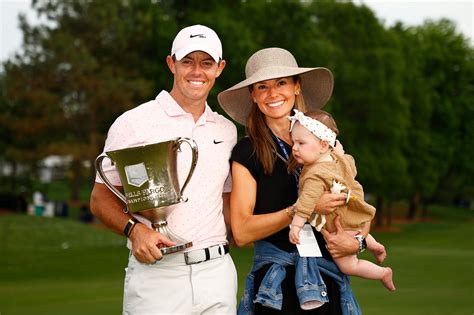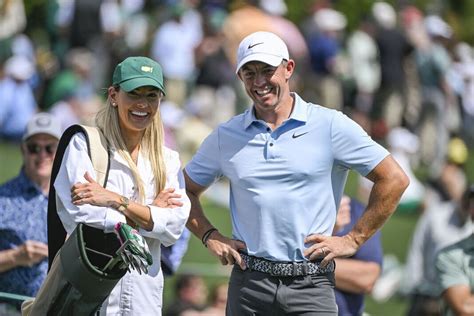
Rory McIlroy’s admission of navigating “two lives” – one as a globally recognized golfer and another as a father and husband – has taken center stage as his wife, Erica Stoll, was noticeably absent from the U.S. Open at Pinehurst No. 2, fueling speculation about the state of their marriage following McIlroy’s recent filing for divorce.
Rory McIlroy’s pursuit of his first major championship in a decade is unfolding under the shadow of his recently announced divorce proceedings, adding a layer of complexity to his performance at the U.S. Open. McIlroy, who filed for divorce from his wife, Erica Stoll, just before the PGA Championship last month, has openly acknowledged the challenges of balancing his demanding professional career with his personal life, referring to it as leading “two lives.” The absence of Stoll from Pinehurst No. 2, where McIlroy is vying for his fifth major title, has further intensified scrutiny on his personal life and its potential impact on his game.
McIlroy’s admission of “two lives” underscores the unique pressures faced by elite athletes who must juggle intense competition, constant travel, and public scrutiny with the desire for a stable and fulfilling personal life. The divorce filing, initiated in Florida, where the couple resides, cited that the marriage was “irretrievably broken,” marking a significant turning point in McIlroy’s life both on and off the course. The golfer’s representatives have stressed the need for privacy and respect for the couple’s wishes as they navigate this difficult period, particularly for the sake of their three-year-old daughter, Poppy Kennedy McIlroy.
Despite the personal turmoil, McIlroy has demonstrated remarkable resilience, maintaining a high level of performance on the golf course. His recent victory at the RBC Canadian Open, where he secured his 26th professional win, showcased his ability to compartmentalize his personal challenges and focus on his game. However, the U.S. Open presents a different kind of challenge, with the demanding course conditions and the weight of expectations adding to the mental and emotional strain.
The spotlight on McIlroy’s personal life has inevitably raised questions about its potential impact on his performance at Pinehurst No. 2. While McIlroy has consistently stated his commitment to focusing on golf, the distraction of the divorce proceedings cannot be entirely dismissed. The absence of his wife, who has been a constant presence at his tournaments in the past, serves as a stark reminder of the personal challenges he is facing.
The timing of the divorce filing, just before two major championships, has also been a subject of speculation. Some observers have questioned whether the stress and emotional toll of the proceedings could hinder McIlroy’s ability to perform at his best. Others have suggested that McIlroy’s decision to address the personal issues head-on could ultimately free him to focus more intently on his game.
McIlroy’s “two lives” are not unique to him. Many professional athletes face similar challenges in balancing their careers with their personal lives. The constant travel, the pressure to perform, and the demands of sponsors and endorsements can take a toll on relationships. However, McIlroy’s case is particularly high-profile due to his status as one of the world’s most recognizable golfers and the public nature of his divorce proceedings.
The golfer’s relationship with Erica Stoll began in 2012, and they were married in a lavish ceremony at Ashford Castle in Ireland in 2017. Stoll, a former PGA of America employee, has generally maintained a low profile, preferring to support McIlroy from behind the scenes. Her absence from the U.S. Open is a departure from her usual practice and has fueled further speculation about the state of their marriage.
As McIlroy continues his quest for his fifth major championship, he faces the daunting task of managing his personal challenges while competing at the highest level of professional golf. The outcome of the U.S. Open will undoubtedly be shaped by his ability to navigate these “two lives” and maintain his focus amidst the distractions. The world watches to see if McIlroy can once again compartmentalize these competing demands and achieve the greatness on the course he is known for, despite the turbulence in his personal life.
The U.S. Open poses a stern test of McIlroy’s mental fortitude, especially given the circumstances. Pinehurst No. 2, with its challenging greens and unforgiving sandy areas, demands precision and composure. Any lapse in concentration could prove costly, and the pressure to perform is magnified by the scrutiny surrounding McIlroy’s personal life.
Despite the challenges, McIlroy remains a formidable competitor. His talent, experience, and determination are undeniable. He has demonstrated his ability to overcome adversity in the past, and he is determined to add another major championship to his resume.
The coming days will reveal whether McIlroy can successfully navigate his “two lives” and achieve his goals at the U.S. Open. The world will be watching closely as he seeks to balance his personal challenges with his professional aspirations.
The broader context of McIlroy’s situation highlights the pressures faced by professional athletes who are constantly in the public eye. Their personal lives are often scrutinized, and their relationships are subject to intense media attention. The challenge of maintaining a sense of normalcy and privacy can be overwhelming, and the demands of their careers can strain even the strongest relationships.
McIlroy’s case serves as a reminder of the human element behind the athletic achievements we celebrate. He is not just a golfer; he is also a husband, a father, and an individual facing personal challenges. His ability to navigate these complexities will be a defining factor in his success both on and off the course.
His performance at the U.S Open will be scrutinized not only for his golfing abilities, but also how he carries himself, how he addresses the media, and how well he appears to manage the enormous pressure he faces. It is a test that extends well beyond the fairways and greens of Pinehurst No. 2.
The story of Rory McIlroy at the 2024 U.S. Open is more than just a golf tournament; it is a human drama playing out on a global stage. It is a story of talent, ambition, personal challenges, and the relentless pursuit of excellence. Whether he triumphs or falters, McIlroy’s journey will undoubtedly resonate with fans around the world who can appreciate the complexities of life at the highest level of professional sports.
The world of golf eagerly awaits to see if McIlroy can silence the noise and secure his first major in 10 years, a victory that would undoubtedly be one of the most compelling stories of his career, a testament to his resilience, his focus, and his ability to navigate the “two lives” that currently define his existence.
The legal proceedings surrounding the divorce are expected to be complex and potentially drawn out. Details regarding the division of assets and custody arrangements for their daughter, Poppy, are likely to remain private, but the process will undoubtedly add further stress to McIlroy’s life. The golfer has hired a prominent legal team to represent him in the proceedings, signaling his intention to protect his interests and ensure the best possible outcome for his family.
Furthermore, the impact of this situation on McIlroy’s endorsements and sponsorship deals remains to be seen. While his on-course performance is the primary driver of his commercial value, his personal image also plays a significant role. Companies that have invested heavily in McIlroy as a brand ambassador will be closely monitoring the situation and assessing any potential impact on their partnerships.
However, McIlroy’s track record suggests that he is capable of weathering this storm. He has consistently demonstrated a remarkable ability to separate his personal life from his professional life, and he has a strong support system in place to help him navigate these challenges. His coach, his caddie, and his close friends and family will all play a crucial role in helping him maintain his focus and perform at his best.
The U.S. Open provides McIlroy with an opportunity to not only win a major championship but also to demonstrate his resilience and his ability to overcome adversity. A strong performance at Pinehurst No. 2 would send a powerful message that he is capable of navigating his personal challenges while still competing at the highest level of professional golf.
As McIlroy embarks on this challenging chapter of his life, he can draw inspiration from other athletes who have successfully navigated similar situations. Many professional athletes have faced personal challenges while maintaining their focus and achieving success in their respective sports. Their stories serve as a reminder that it is possible to overcome adversity and achieve one’s goals, even in the face of significant personal turmoil.
Ultimately, McIlroy’s success at the U.S. Open and beyond will depend on his ability to manage his emotions, maintain his focus, and rely on his support system. He has the talent and the experience to overcome these challenges, but it will require a tremendous amount of mental fortitude and resilience. The world will be watching closely to see if he can rise to the occasion and achieve his goals, both on and off the course.
The absence of Erica Stoll at the U.S. Open speaks volumes, and it’s a visible manifestation of the “two lives” McIlroy has acknowledged. While he professionally aims for victory, the personal complexities are undeniable. Golf enthusiasts and casual observers alike recognize the added pressure McIlroy faces, transforming the tournament into more than just a sporting event—it’s a window into the challenges of a life lived in the spotlight. His ability to block out the external distractions and focus on the game could become the deciding factor in his quest for a major victory.
Examining the timeline, the divorce filing occurred just before the PGA Championship, creating a constant undercurrent of speculation and scrutiny. While McIlroy has been publicly composed, addressing the situation as necessary and then diverting attention back to the golf, the timing is strategically problematic. It places him in a position where every move, every reaction, and every shot are analyzed through the lens of his personal circumstances.
Despite the difficult circumstances, one could argue that confronting his personal issues head-on might provide some mental relief for McIlroy. Rather than suppressing the problems, addressing them could allow him to compartmentalize his life more effectively, preventing the personal issues from seeping into his performance on the golf course. This approach requires significant emotional strength, but if successful, it could free him to focus more intensely on his game.
The contrasting elements of this situation further enhance the drama. On one hand, McIlroy is striving for a major victory, aiming to solidify his legacy as one of the greatest golfers of his generation. On the other hand, he is grappling with the dissolution of his marriage, a deeply personal and emotional experience. These conflicting forces create a compelling narrative that resonates with many people, regardless of their interest in golf.
The media’s role in this situation is also significant. The constant coverage of McIlroy’s personal life inevitably adds to the pressure he faces. While the golfer has generally maintained a respectful and professional demeanor, the intrusive nature of the media can be overwhelming. Balancing the need to address the situation publicly with the desire for privacy is a difficult task, and McIlroy’s ability to navigate this dynamic will be closely watched.
In summary, the Rory McIlroy saga at the U.S. Open is a complex and multi-faceted story. It involves a talented athlete striving for excellence in his profession while simultaneously navigating significant personal challenges. The absence of his wife, Erica Stoll, is symbolic of the “two lives” McIlroy has acknowledged, and it underscores the difficulty of balancing a high-profile career with a fulfilling personal life. The coming days will reveal whether McIlroy can successfully manage these competing demands and achieve his goals, both on and off the course.
The broader impact of McIlroy’s situation extends beyond the world of golf. It serves as a reminder that even the most successful and admired individuals face personal challenges. His ability to navigate these challenges with grace and resilience can serve as an inspiration to others who are facing similar difficulties.
His story is a testament to the human spirit and the ability to overcome adversity. It is a reminder that even in the face of personal turmoil, it is possible to maintain focus, pursue one’s goals, and achieve success. McIlroy’s journey at the U.S. Open is more than just a golf tournament; it is a reflection of the complexities and challenges of life, and it is a reminder that even the most celebrated athletes are, ultimately, human beings.
The narrative also touches upon societal expectations of athletes. They are often seen as larger-than-life figures, expected to perform flawlessly both on and off the field. McIlroy’s situation highlights the unrealistic nature of these expectations and the toll they can take on individuals who are already under immense pressure.
Ultimately, McIlroy’s story is a reminder that success is not just about winning championships or achieving professional goals. It is also about navigating personal challenges with grace, resilience, and a commitment to one’s values. Whether he wins the U.S. Open or not, McIlroy’s ability to manage his “two lives” will be a defining aspect of his legacy.
Frequently Asked Questions (FAQ)
Q1: Why is Rory McIlroy’s divorce being discussed in relation to the U.S. Open?
A1: Rory McIlroy filed for divorce from his wife, Erica Stoll, shortly before the PGA Championship. This personal matter has drawn media attention and raised questions about its potential impact on his performance at the U.S. Open. His admission of living “two lives” has further amplified these concerns, and his wife’s absence from the tournament has been noted.
Q2: What does McIlroy mean by “two lives”?
A2: McIlroy has described his life as a balancing act between his demanding career as a professional golfer and his personal life as a husband and father. The constant travel, competition, and public scrutiny associated with his profession create a unique set of challenges in maintaining a stable and fulfilling personal life.
Q3: How has McIlroy performed since the divorce filing?
A3: Despite the personal turmoil, McIlroy has maintained a high level of performance. He recently won the RBC Canadian Open, demonstrating his ability to focus on his game amidst the distractions. However, the U.S. Open presents a different challenge, with the demanding course conditions and the weight of expectations adding to the mental and emotional strain.
Q4: Will the divorce proceedings affect McIlroy’s sponsorship deals?
A4: It’s possible. While on-course performance is the primary driver of McIlroy’s commercial value, his personal image also plays a significant role. Companies that have invested heavily in McIlroy as a brand ambassador will be closely monitoring the situation and assessing any potential impact on their partnerships. So far, there’s no explicit indication of deals being changed, however.
Q5: What are the key challenges McIlroy faces at the U.S. Open given his personal situation?
A5: McIlroy faces several key challenges: managing his emotions, maintaining his focus amidst the distractions, and relying on his support system. The U.S. Open course, Pinehurst No. 2, is demanding and requires precision and composure. Any lapse in concentration could prove costly. Furthermore, the pressure to perform is magnified by the scrutiny surrounding his personal life. His ability to compartmentalize his personal issues and focus on the game will be crucial to his success.









